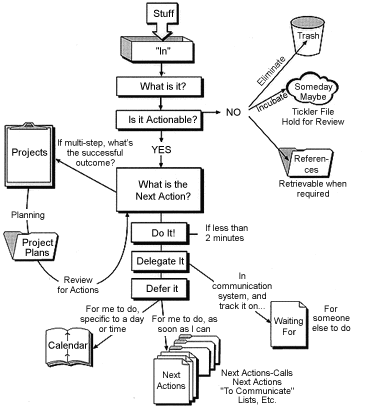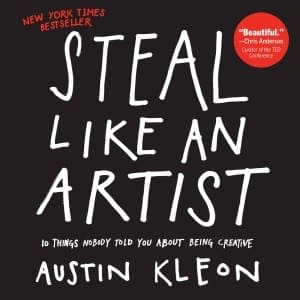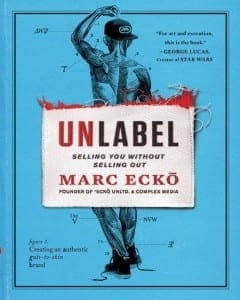I absolutely love that feeling of finishing a good book. Being filled with inspirations and ideas, buzzing with excitement to try a new idea. I love that somehow whatever issues I’m dealing with at the time, the book will unlock a solution or spark a new path.
The benefits of habitual reading are many. Amazingly, research has shown that reading can help create new synapses (brain pathways) and strengthens existing ones, which assists in short-term memory recall as well as stabilizing moods.
I’ve personally found the following benefits from reading.
- Mental Stimulation
- Stress Reduction
- Knowledge
- Vocabulary Expansion
- Memory Improvement
- Stronger Analytical Thinking Skills
- Improved Focus and Concentration
- Better Writing Skills
- Tranquility
- Entertainment
I read a healthy list fiction, Murakami, Chuck Palahniuk, Tom Robbins, and Christopher Moore are some of my favorite fiction authors. However, the last few years have been big for me with starting two new businesses and learning to manage people so many of the books I read were focused on self-improvement and real world examples of peoples and companies I look up to. I tend to watch movies and television series for the much needed distractions (Mad Men, The Walking Dead, The Wire being some of my favorites).
As 2015 rolled by, I thought it would be worth a share to refresh myself with the books I read in 2014 and share them with my communities. So here’s my list of books I recommend for anyone looking to dive into the world of business books.
1. The $100 Startup by Chris Guillebeau
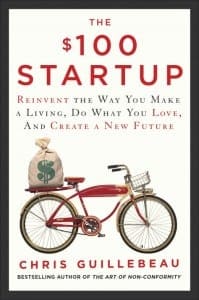 Chris Guillebeau is a fantastic writer. He’s clear, concise and gets to the point. The $100 Startup is a quick read with lots of side notes and examples. Chris walks you through the process of finding a business idea that’s right for you, setting up the business and, the most important step that most wantrapreneurs miss, launching the business.
Chris Guillebeau is a fantastic writer. He’s clear, concise and gets to the point. The $100 Startup is a quick read with lots of side notes and examples. Chris walks you through the process of finding a business idea that’s right for you, setting up the business and, the most important step that most wantrapreneurs miss, launching the business.
The book is broken up into three major parts:
- Unexpected Entrepreneurs. This section covers how to connect your skills and interests with what other people want.
- Taking it to the Streets. In this section, the book digs into the details with a one-page business plan, guide for creating a “killer offer,” and how to raise funds, launch, and hustle for customers.
- Leverage and Next Steps. Here’s where you learn about how to test pricing and positioning, create a franchise, grow in line with your goals, and push past failure.
A favorite quote:
“To succeed in a business project, especially one you’re excited about, it helps to think carefully about all the skills you have that could be helpful to others and particularly about the combination of those skills.”
2. The Lean Startup by Eric Ries
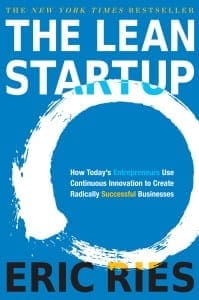 The first couple of chapters are really dry but once you get into it, things start to roll. Eric Ries defines a startup as an organization dedicated to creating something new under conditions of extreme uncertainty.
The first couple of chapters are really dry but once you get into it, things start to roll. Eric Ries defines a startup as an organization dedicated to creating something new under conditions of extreme uncertainty.
Rather than wasting time creating elaborate business plans, The Lean Startup offers entrepreneurs – in companies of all sizes – a way to test their vision continuously, to adapt and adjust before it’s too late. Ries provides a scientific approach to creating and managing successful startups in a age when companies need to innovate more than ever.
A favorite quote:
“As you consider building your own minimum viable product, let this simple rule suffice: remove any feature, process, or effort that does not contribute directly to the learning you seek.”
3. Manage Your Day-to-Day: Build Your Routine, Find Your Focus, and Sharpen Your Creative Mind (The 99U Book Series) by
by
 In this ever changing world, we are constantly bombarded by distractions, new ways of working, and being asked to do more with less. In Manage Your Day-to-Day, the team at 99U have collected a series of short essays from creative leaders about how they create routines to stay productive and focused.
In this ever changing world, we are constantly bombarded by distractions, new ways of working, and being asked to do more with less. In Manage Your Day-to-Day, the team at 99U have collected a series of short essays from creative leaders about how they create routines to stay productive and focused.
Contributors include Scott Belsky, Seth Godin, Todd Henry, Scott McDowell, and more.
A favorite quote:
“Today’s challenge is to keep your focus and preserve the sanctity of mind required to create, and to ultimately make an impact in what matters most to you. This can only happen when you capitalize on the here and now. To do this, alternate periods of connectedness with periods of truly being present.
“
4. Rework by Jason Fried and David Heinemeier Hansson
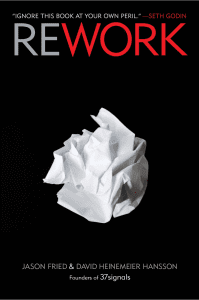 Jason Fried and David Heinemeier Hansson are the founders of 37 Signals which they renamed to more simply, Basecamp, and writers of a wildly popular blog, Signal vs. Noise. We absolutely love using Basecamp. Every single project we take on gets a Basecamp project to help us stay organized and communicate effectively.
Jason Fried and David Heinemeier Hansson are the founders of 37 Signals which they renamed to more simply, Basecamp, and writers of a wildly popular blog, Signal vs. Noise. We absolutely love using Basecamp. Every single project we take on gets a Basecamp project to help us stay organized and communicate effectively.
Rework really digs into the art of keeping a company lean. They talk about resisting the urge to add extra features to a product. They take a very Apple approach to things. They edit their product down to the absolute bare minimum and make sure that those features work and work well. A simple and easy read that will most definitely inspire you to take a fresh look at your work.
A favorite quote:
“Plus, if you’re a copycat, you can never keep up. You’re always in a passive position. You never lead; you always follow. You give birth to something that’s already behind the times—just a knockoff, an inferior version of the original. That’s no way to live.”
5. Getting Things Done: The Art of Stress-Free Productivity by David Allen
by David Allen
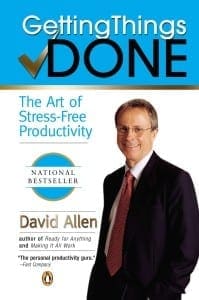 One of the all-time classics. Unlike most business books that are filled with platitudes, hyperbole and cheerleader nonsense., Getting Things Done gives a real world system for, you guessed it, getting things done.
One of the all-time classics. Unlike most business books that are filled with platitudes, hyperbole and cheerleader nonsense., Getting Things Done gives a real world system for, you guessed it, getting things done.
From Lifehacker: GTD is an organizational system. It doesn’t put rules around how you actually do your work. Instead, it focuses on how you capture the work you need to do, organize it, and choose what needs your attention. At its core, GTD stands on five “pillars,” or steps to getting and staying organized:
- Capture everything. Your to-dos, your ideas, your recurring tasks, everything. Put it in a pen-and-paper notebook, a to-do app, a planner, whatever you prefer to use to get organized. GTD doesn’t say to use a specific tool, but whatever you use has to fit into your normal flow. The barrier to using it should be so low that there’s never a reason for you to say “I’ll add it to my list later.” You want to capture everything as soon as it happens so you don’t have to think about it again until it’s time to do it.
- Clarify the things you have to do. Don’t just write down “Plan vacation,” break it down into actionable steps so there’s no barrier to just doing the task. If there’s anything you can do right away and have time to do, get it done. If there’s anything you can delegate, delegate it. Here’s a helpful video where David Allen explains how to clarify your to-dos so they don’t require more time to figure out what you meant than it takes to actually do the thing you wanted to do.
- Organize those actionable items by category and priority. Assign due dates where you can, and set reminders so you follow up on them. Pay special attention to each item’s priority, as well. You’re not actually doing any of the items on your list right now, you’re just making sure they’re in the right buckets for later, and your reminders are set. In short, this is quality time with your to-do list, inbox, and calendar.
- Reflect on your to-do list. First, look over your to-dos to see what your next action should be. This is where the clarifying step pays off, because you should be able to pick something you have the time and the energy to do right away. If you see something that’s so vague that you know you won’t be able to just pick up and run with it, break it down. Second, give your to-do list an in-depth review periodically to see where you’re making progress, where you need to adjust your priorities, and determine how the system is working for you.
- Engage and get to work. Choose your next action and get to it. Your system is, as this point, set up to make figuring that out easy. Your to-dos are organized by priority and placed in categories. You know what to work on, and when. They’re broken into manageable, bite-sized chunks that are easy to start. It’s time to get to work.
6. Steal Like an Artist: 10 Things Nobody Told You About Being Creative by Austin Kleon
by Austin Kleon
Austin Kleon is a talented writer from my hometown, Austin, Texas. His wildly popular tumblr, Newspaper Blackout is a collection of poems made by redacting newspapers with a permanent marker to create poems.
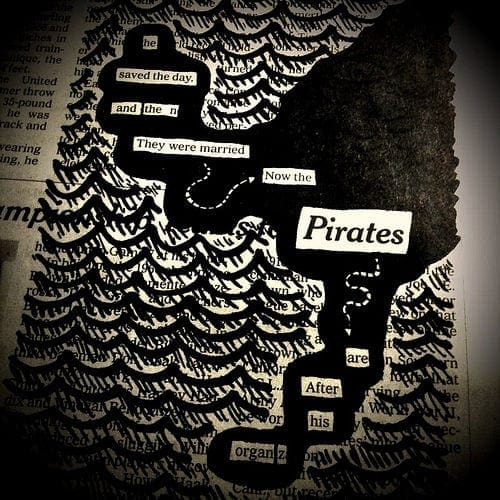
The main points of Steal Like An Artist are the following:
1. Steal like an artist: The author cautions that he does not mean ‘steal’ as in plagiarise, skim or rip off — but study, credit, remix, mash up and transform. Creative work builds on what came before, and thus nothing is completely original.
2. Don’t wait until you know who you are to start making things: You have to start doing the work you want to be doing, you have to immerse, internalise and even dress like the person you aspire to be. “You don’t have to look like your heroes, you want to see like your heroes,” Kleon urges. Go beyond imitation to emulation.
3. Write the book you want to read: It is important to do what you want to do, and insert your take on things of art.
4. Use your hands: It is important to step away from the screen and immerse in actual physical work. “Computers have robbed us of the feeling that we’re actually making things,” Kleon cautions. “Involve your full body, and not just your brains.”
5. Side projects are important: Hobbies are important because they keep you happy. “A hobby is something that gives but doesn’t take,” Kleon says.
6. Do good work and put it where people can see it: Sharing your work and even your thoughts about what you like help you get good feedback and more ideas.
7. Geography is no longer our master: “Travel makes the world look new, and when the world looks new, our brains work harder,” Kleon explains. Constraints can also act favorably – bad winters or summers can force you to be indoors and work on your projects.
8. Be nice (the world is a small town.): Stop fighting and channel your rage into a creative pursuit. Show appreciation for the good things you see around you.
9. Be boring (it’s the only way to get work done.): You can’t be creative all the time, so set a routine – for example, with a regular day job which sets a fixed schedule and exposes you to new people and skills.
10. Creativity is subtraction“: In an age of information overload and abundance, focus is important. Choose what you want to leave out of your key work. “Nothing is more paralysing than the idea of limitless possibilities. The best way to get over creative block is to simply place some constraints on yourself,” Kleon says.
Two favorite quotes:
“If you ever find that you’re the most talented person in the room, you need to find another room.
Draw the art you want to see, start the business you want to run, play the music you want to hear, write the books you want to read, build the products you want to use – do the work you want to see done.”
7. Show Your Work!: 10 Ways to Share Your Creativity and Get Discovered
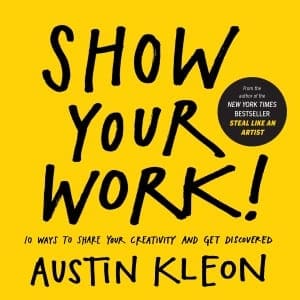
Another great read from Austin Kleon. Less impactful but great for anyone looking to get past the block of pushing their work out to the world. Austin shows how to take that critical next step on a creative journey to getting known. It’s about doing the work to be findable and using your networks instead of wasting time networking “notworking”.
Show Your Work! offers ten transformative rules for being open, generous, brave, productive.
Some of his tips include:
- Put your work out there, share it with others regularly
- Meet up with people in real life, not just on the Internet
- Don’t be afraid to make money off your creative work
- Keep going
- Maintain an e-mail list
- Give proper credit when you refer to other people’s work
A favorite quote:
“But now I realize that the only way to find your voice is to use it. It’s hardwired, built into you. Talk about the things you love. Your voice will follow.”
8. Linchpin: Are You Indispensable? by Seth Godin
by Seth Godin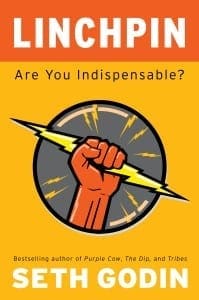
Seth Godin’s Linchpin is likely to the change the way you work by detailing how to become indispensable. In the book Godin makes the distinction between people who follow instruction that he calls “factory workers”, and “linchpins”. According to Godin, A linchpin is an employee who doesn’t need a rule book and brings happiness to those around them, because that’s what they love to do.
Further qualities of a Linchpin are:
- Artists who create daily what Godin describes as “the intentional act of using your humanity to create a change in another person”
- People who use emotional labor
- Workers who fight mental resistance
- Gift givers of things like time and attention.
“Linchpin” doesn’t consist of quick productivity tips and hacks; instead, the book teaches a powerful new way of thinking.
A favorite quote:
“An artist is someone who uses bravery, insight, creativity, and boldness to challenge the status quo. And an artist takes it personally.”
9. Unlabel: Selling You Without Selling Out by Marc Eckō
by Marc Eckō
Marc Eckō, the creator of successful branded platforms—Eckō Unltd. and Complex Media, empowers readers to channel creativity in Unlabel. The book breaks through traditional boundaries by proving you can be both a successful business marketer and a true artist.
Marc Eckō boldy and openly shares both his bruising business mistakes and remarkable triumphs to teach readers how to grow both creatively and commercially. Unlabel challenges readers to test their personal brand against the principles of the Authenticity Formula.
This book is a must read for those aspiring to grow a bootstrap start-up into a sustainable business.
A favorite quote:
“Reduce risk, lower your required capital, and focus on what you’re really good at—and hire others for what you are not.) This is something you should think about in any business: don’t try to do everything. You aren’t the best at everything. Find out where you have an advantage and stick to that. “
10. The Power of Habit: Why We Do What We Do in Life and Business by Charles Duhigg
by Charles Duhigg
The Power of Habit contains a compelling argument: the key to achieving any kind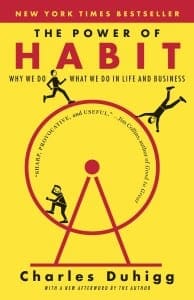
ofsuccess is understanding how habits work. Charles Duhigg sites companies that have become house hold names and describes how they have succeeded by transforming habits. In doing this, Duhigg brings a whole new understanding of human nature and its potential for transformation.
Duhigg starts with a framework: At the core of every habit is a simple, three part, neurological loop:
- a cue
- a routine
- a reward.
Duhigg also details the power of weak ties, what he describes as the links that connect people who have acquaintances in common, or who share social networks, but aren’t directly connected by strong ties of friendship themselves.
“The habits of peer pressure, however, have something in common. They often spread through weak ties. And they gain their authority through communal expectations.”
This book is a must read for those who want to understand how habits shape companies, organizations and communities.
Bonus
I posted this list to Reddit and people came back with a list of solid suggestions.
- Good to Great: Why Some Companies Make the Leap…And Others Don’t
by Jim Collins
- The Ultimate Sales Machine: Turbocharge Your Business with Relentless Focus on 12 Key Strategies by Chet Holmes
- How to Win Friends and Influence People by Dale Carnegie
- 22 Immutable Laws of Marketing by Al Ries
- Blue Ocean Strategy, Expanded Edition: How to Create Uncontested Market Space and Make the Competition Irrelevant by W. Chan Kim
- Predictably Irrational, Revised and Expanded Edition: The Hidden Forces That Shape Our Decisions by Dan Ariely
- Crossing the Chasm, 3rd Edition: Marketing and Selling Disruptive Products to Mainstream Customers by Geoffrey A. Moore
- All Marketers Are Liars: The Underground Classic That Explains How Marketing Really Works–and Why Authenticity Is the Best Marketing of All by Seth Godin
- SPIN Selling by Neil Rackham
- Think and Grow Rich: The Landmark Bestseller – Now Revised and Updated for the 21st Century by Napoleon Hill
- The Richest Man in Babylon by George S. Clason
- All In by Arlene Dickinson
- Rich Dad Poor Dad: What The Rich Teach Their Kids About Money That the Poor and Middle Class Do Not! by Robert Kiyosaki
- The Entrepreneur Roller Coaster: Why Now Is the Time to #Join the Ride by Darren Hardy
- Slicing Pie: Funding Your Company Without Funds by Mike Moyer
- Zero to One: Notes on Startups, or How to Build the Future by Peter Thiel
- Zag: The Number One Strategy of High-Performance Brands by Marty Neumeier
- How to Get Rich: One of the World’s Greatest Entrepreneurs Shares His Secrets by Felix Dennis
- Winning Through Intimidation by Robert J. Ringer
- The War of Art: Break Through the Blocks and Win Your Inner Creative Battles – Steven Pressfield (not strictly business, but very good for personal development)
- The Dip – Seth Godin
- Business Adventures: Twelve Classic Tales from the World of Wall Street by John Brooks
- Predictably Irrational, Revised and Expanded Edition: The Hidden Forces That Shape Our Decisions by Dan Ariely
- Influence: The Psychology of Persuasion, Revised Edition by Robert B. Cialdini
- Driven: How To Succeed In Business And In Life by Robert Herjavec
- Platform: Get Noticed in a Noisy World by Michael Hyatt
- The Retail Doctor’s Guide to Growing Your Business: A Step-by-Step Approach to Quickly Diagnose, Treat, and Cure by Bob Pibbs
- Why We Buy: The Science of Shopping–Updated and Revised for the Internet, the Global Consumer, and Beyond by Paco Underhill
- Anything by Malcom Gladwell, Dan Heath and Chip Heath,Michael Lewis and Richard Branson.
Wrap Up
So there you go, that should hold you over for the year. I hope you got something out of this post and have a list of business books you are excited to read in 2015. If I missed one of your favorites, please leave me and comment and I’ll be happy to add it to this list in an addendum. Here’s to a fantastic 2015 full of life, learning, knowledge, growth and prosperity.
*This post was inspired by Buffer’s list of their 19 favorite books of 2014.



